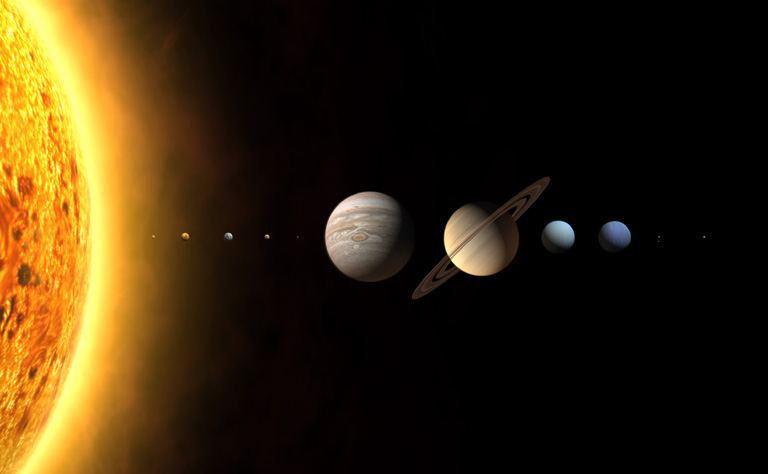 |
|
The Earth |
|
o


|
| |
|
|
| |
|
|
| |
|
|
 The Earth as "this scepter'd isle. This earth of majesty"[1] among the cosmic and spatial voids is among the rarest of places. Lynn Margulis
calls it a Symbiotic Planet, because
the life which transformed the air and water of Earth is really a composite
of mutually supportive beings often struggling to nourish and be nourished. The Earth as "this scepter'd isle. This earth of majesty"[1] among the cosmic and spatial voids is among the rarest of places. Lynn Margulis
calls it a Symbiotic Planet, because
the life which transformed the air and water of Earth is really a composite
of mutually supportive beings often struggling to nourish and be nourished. |
| |
|
|
|
|
|
Terra was the Latin
word for the Earth, once thought to be the center of space. Even more, Terra was thought to be the anchor of the
planets and stars that appeared to encircle the night sky. Chinese and Persians first suggested that our planet did actually move around its axis and thus was not this fixed and stable Earth as a focal point or central place of the universe. By moving on its axis the Earth gives us the illusion that the heavens are moving around our planet. Kepler proved that the Earth rotates on an axis and revolves around the sun. His laws of planetary motion account for the behavior of the planets moving about the sun as they appear to wander in our night sky. Today we also know there is no universal center of all space.
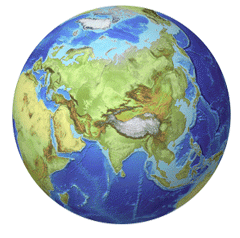
Earth is a rare and unusual place in that water exists on the surface in three states: solid, liquid and vaporous gas. Because water is compounded of hydrogen and oxygen, through a rare life sparked event, oxygen is the signature element of our planet's spectrum, if we could see that from outer space. Our home planet, even from it's origins in the early solar system is most rare.
"These pre-planets collided to create even larger planets. This set the stage for how the Earth approached its final form. It looks like it probably collided with a another proto-planet and in the process it was tilted.
All the same the Earth’s tilt is very important. It is perfectly positioned so that it gives us the seasons and on top of that the seasons are near perfectly calibrated for life. When compared with other planets Earth’s tilt allows for season that are not too extreme in temperature but are pretty well balanced. At the same if it had stay in the 'perfect' position one side of the Earth would be too hot at time and then too cold."
Tega Jessa
WHY IS THE EARTH TILTED?
Article Updated: 5 Jan , 2016 "Universe Today."
Space is a largely
empty area –but filled with subatomic particles– we share.
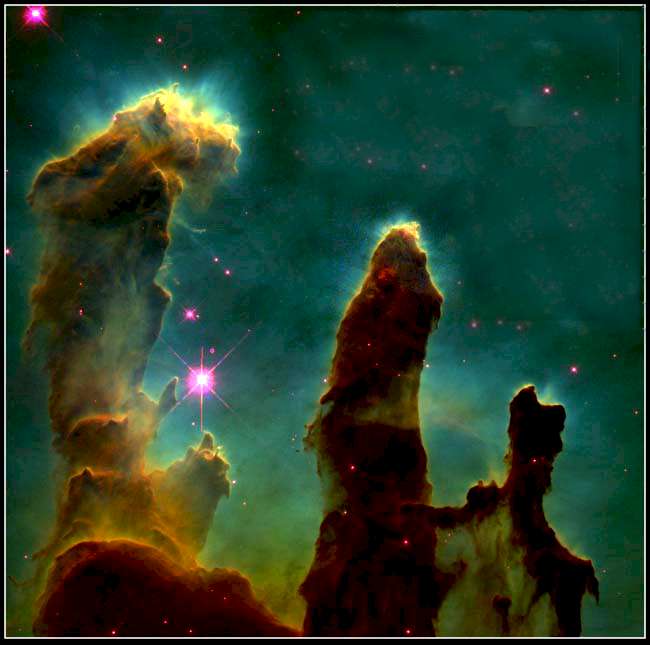
“formaldehyde and hydrogen cyanide appear in interstellar space.” source
 The elements
The elements
Hydrogen is fused into helium as the fuel that drives all stars, such as our sun; a fusion engine.
H ––> He and 3 He = C
Carbon "formed in a star whenever three helium nuclei collide at one spot within less than a million millionth of a second. Every carbon atom in every living creature has been formed by such a wildly improbable collision."
Jacob Bronowski, The Ascent of Man, 1972
Adenine is five correctly ordered H - hydrogen cyanides
p.147, Cosmos Earth and Man, Preston Cloud
The compound of water comprised of the elements of hydrogen & oxygen exist on earth in three profoundly important states: solid, vapor-gas, & liquid.
This fact many authorities suggest is the most important feature of the earth; where seventy-two percent of the surface is covered by liquid water but this compound exists as a three percent salt solution. In reality if the planet shrunk to the size of a large house, then available drinking water would fit into a golf ball.
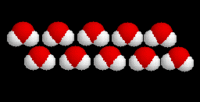
"The model suggests what we already know: water molecules have much different properties than hydrogen or oxygen; specifically, they tend to clump together to form a liquid. Each molecule of a compound is made up of two (or more) different kinds of atoms."
Source: University of Massachusetts microbiology laboratories.
Elements, despite their name are not elemental but made of particles and waves.
Other particles in the architecture of matter exist, such as:
electrons (leptons)

&
neutrons and protons of the atomic
nuclei

Electrons are the shifters of our universe.
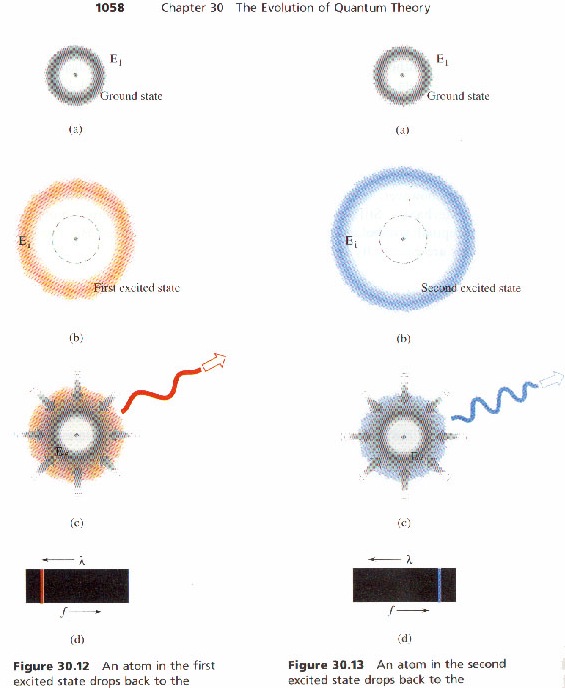

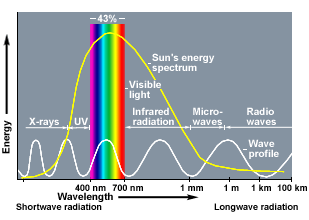


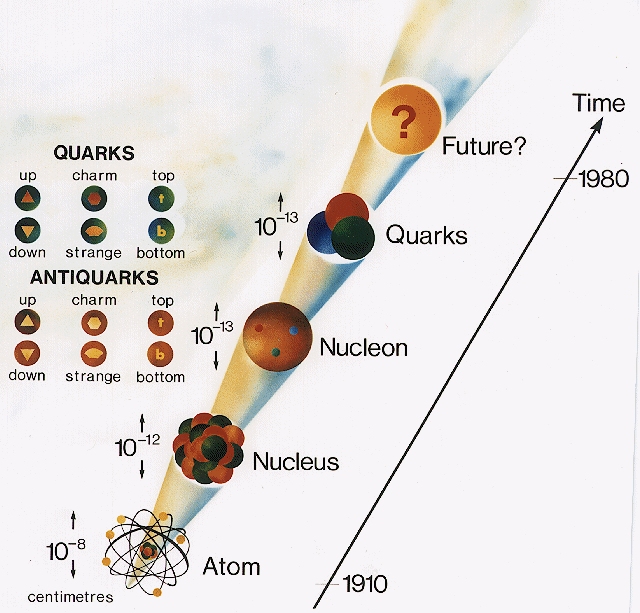
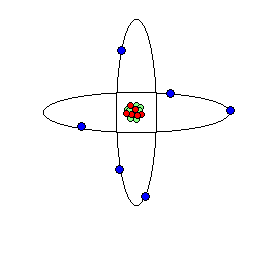 Atoms are believed to be made of electrons, neutrons and protons which are built up
from quarks. For reason to do with the weak force, every thirteen minutes a
down quark decays into an up
quark, transforming the very abundant neutrons into positively charged,
protons, the atomic building block of chemical matter.
Atoms are believed to be made of electrons, neutrons and protons which are built up
from quarks. For reason to do with the weak force, every thirteen minutes a
down quark decays into an up
quark, transforming the very abundant neutrons into positively charged,
protons, the atomic building block of chemical matter.
Nuclei
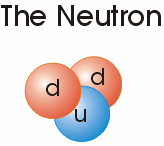
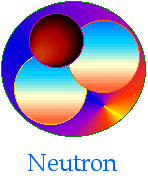
Quarks are the smallest constituent material of all living and nonliving things.
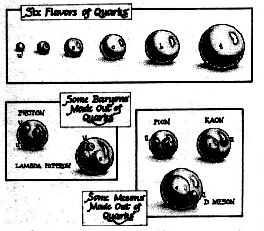
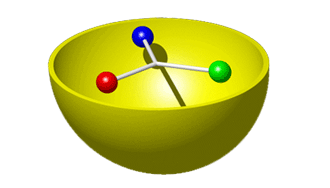
There are some in physics who suggest that the mathematical
formulas are simplified at ever higher dimensions and reveal that all particles
and waves are really the vibration of tiny –extremely miniscule– strings.
The vibrating frequency of the superstrings determines the type of subatomic
particle, quarks or leptons that exist in the four dimensions we experience
as spacetime.

|
|
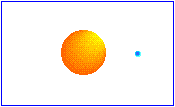
|
|
| |
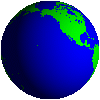
|
| |
The curvature of spacetime is beyond our sensory confirmation capacities. |
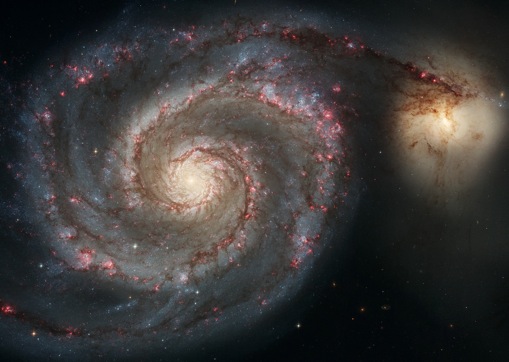
The great Andromeda galaxy, our closest neighbor is two million light years from our own Milky Way galaxy; such is the vastness of intergalactic space by comparison we are thirty light years from our nearest star, another sun called Proxima Centauri.
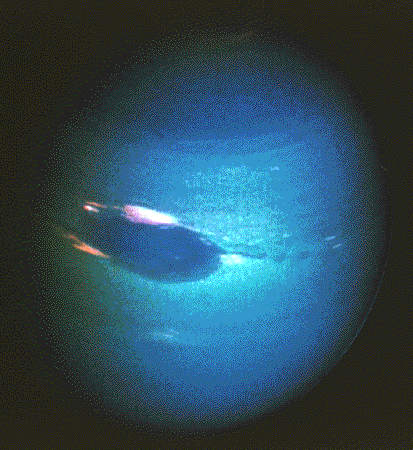
Neptune –with clouds in its atmosphere– is now our sun's outermost planet.
How rare is our earth among the billions of stars among the billions of galaxies? 
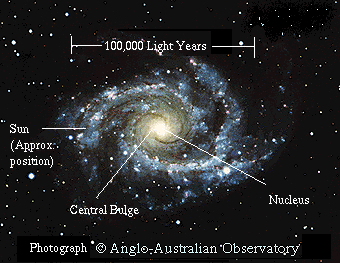
The earth our native ground is a child of the sun.
Peter Ward & Donald Brownlee, Rare Earth: Why Complex Life is Uncommon in the Universe.
"We number among a select few."
"Earth has been orbiting a star with relatively constant energy output for billions of years . . .life . . .not only needs much more benign condition but also must have those conditions present and stable for great lengths of time. Yet it took 2 billion years [2,000 million] for enough oxygen to be produced to allow animals on Earth."
pp. xv, xxi.
"Our planet was without animal life for the first 3.5 billion years of its existence and without animals large enough to leave a visible fossil record for nearly 4 billion years. But when, 550 million years ago, sizable and diverse animal life finally burst into the oceans, it did so with a figurative bang–in a relatively sudden event known as the Cambrian Explosion."
Rare Earth: Why Complex Life is Uncommon in the Universe. pp. 125.
Universe
| Kaku on Hyperspace | Hyperspace
explained | Levels in the organization of
the cosmos | Science
Source
Richard II, Act 2 (William Shakespeare)
"This royal throne of kings, this scepter'd isle,
This earth of majesty, this seat of Mars,
This other Eden, demi-paradise,
This fortress built by Nature for herself
Against infection and the hand of war,
This happy breed of men, this little world,
This precious stone set in the silver sea,
Which serves it in the office of a wall,
Or as a moat defensive to a house,
Against the envy of less happier lands,
This blessed plot, this earth, this realm, this England"

Planet

Earth & Sun

Maps | concept map | earth quiz | solar system | Genetics | Science Index | Analysis | Population Index | Global
Warming Index | Nature Index | Brief


 The Earth as "this scepter'd isle. This earth of majesty"[1] among the cosmic and spatial voids is among the rarest of places. Lynn Margulis
calls it a Symbiotic Planet, because
the life which transformed the air and water of Earth is really a composite
of mutually supportive beings often struggling to nourish and be nourished.
The Earth as "this scepter'd isle. This earth of majesty"[1] among the cosmic and spatial voids is among the rarest of places. Lynn Margulis
calls it a Symbiotic Planet, because
the life which transformed the air and water of Earth is really a composite
of mutually supportive beings often struggling to nourish and be nourished.
















